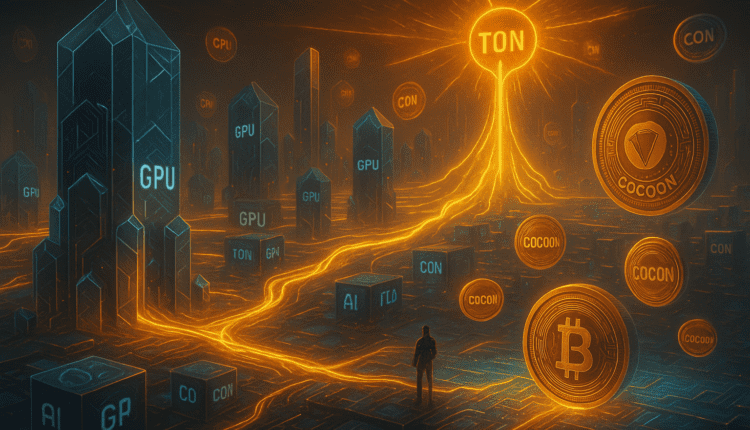How Cocoon Plans to Pay GPU-Owners in Crypto: Token Model, Incentives & Network Economics Explained

Following Pavel Durov reveal of Cocoon on the TON network, attention now turns to its token-driven incentive model — how GPU-owners will earn crypto by powering AI workloads.
Incentive Engine: Turning Compute Power Into On-Chain Yield
At the heart of Cocoon lies a simple promise: if you contribute computing power, you get paid in crypto.
Cocoon introduces a Confidential Compute Open Network where GPU-owners can rent out processing capacity for AI inference and model training while earning verifiable on-chain rewards.
Online advertising service 1lx.online
Although official token details remain unconfirmed, early developer documentation hints at a dual-layer structure:
- Primary settlement in TON, used for network fees and validator staking.
- A potential native utility token (“COCOON”) for compute pricing, governance, and long-term incentive alignment.
This mirrors the “dual-asset economy” used in other decentralized GPU projects such as Render (RNDR) and Akash (AKT), allowing transactional stability while rewarding early network participants with higher-risk upside.
As discussed in our previous coverage, Durov sets November launch for Cocoon, the project positions TON as more than a payments chain — as a foundation for decentralized AI infrastructure.
Token Design: Staking, Lock-Ups & Governance
Pre-launch materials outline a three-part incentive loop designed to attract both GPU-owners and AI developers:
- Compute Staking Model – Providers lock a portion of TON or COCOON as collateral, ensuring uptime and data integrity.
- Usage Rewards – Smart-contracts pay out automatically in crypto once workloads are verified via zero-knowledge attestations.
- Governance Access – Token holders can vote on pricing curves, node standards, and reward halving schedules.
This approach ensures skin in the game for every participant — miners, validators, and developers alike — creating what Cocoon calls a “trust-minimized compute market.”
If implemented effectively, GPU-owners could realize real-world yield on idle hardware while helping decentralize the AI economy.
Online advertising service 1lx.online
Comparative Lens: How Cocoon Differs From Other Compute Networks
Cocoon’s architecture shares DNA with Render and Bittensor but diverges in two critical ways:
- Confidential Compute Layer — Unlike public rendering jobs, Cocoon encrypts and verifies workloads, protecting proprietary AI data.
- Telegram Integration via TON — The network’s access to Telegram’s ecosystem may bootstrap millions of potential node operators and users instantly.
By contrast, Ethereum and Solana-based validator models focus on transaction consensus, not data computation. Cocoon bridges this gap, turning AI compute itself into a decentralized economic primitive.
“If Cocoon succeeds, GPUs become yield-bearing assets the way validators did on Ethereum,” one analyst told BTCNews.space.
“That changes the definition of staking entirely.”
Online advertising service 1lx.online
Risks & Reward Balance
Despite its promise, Cocoon faces technical and economic hurdles:
- Competition vs Cloud Giants – Amazon and Google’s pricing efficiency will pressure margins.
- Data Confidentiality – Running private AI models on decentralized nodes requires bullet-proof encrypted enclaves.
- Network Reliability – GPU nodes vary in performance; maintaining enterprise-grade uptime will determine adoption.
Moreover, token incentives can cut both ways: over-issuance risks inflation, while under-rewarding early providers could stall growth. Cocoon’s success will hinge on balancing speculative yield with sustainable economics.
Market Outlook: Early Staking and Speculative Demand
Speculators are already eyeing potential COCOON airdrops or pre-staking rounds, similar to early GPU networks in 2023–2024.
If TON becomes the settlement backbone, staking demand could lift its DeFi TVL and reinforce token velocity across the ecosystem.
Historically, infrastructure tokens with real economic utility outperform purely narrative-driven assets — a theme we highlighted in Bitcoin ETF paradox: price strength meets record outflows when capital rotated into productive on-chain assets.
Our creator. creates amazing NFT collections!
Support the editors - Bitcoin_Man (ETH) / Bitcoin_Man (TON)
Pi Network (Guide)is a new digital currency developed by Stanford PhDs with over 55 million participants worldwide. To get your Pi, follow this link https://minepi.com/Tsybko and use my username (Tsybko) as the invite code.
Binance: Use this link to sign up and get $100 free and 10% off your first months Binance Futures fees (Terms and Conditions).
Bitget: Use this link Use the Rewards Center and win up to 5027 USDT!(Review)
Bybit: Use this link (all possible discounts on commissions and bonuses up to $30,030 included) If you register through the application, then at the time of registration simply enter in the reference: WB8XZ4 - (manual)
